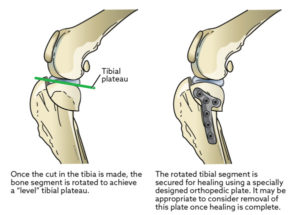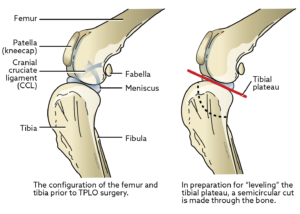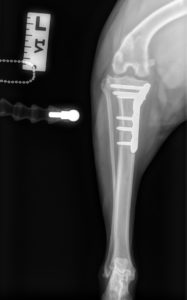THE INJURY
A cranial cruciate ligament (CCL) injury is common in dogs and occurs occasionally in cats. This is similar to an injury to your ACL (anterior cruciate ligament).
In most cases, a CCL tear in dogs is a degenerative condition rather than a single acute injury. This condition causes inflammation, swelling of the joint, and instability of the knee resulting in lameness. Over time, arthritic changes and muscle atrophy ensue.
With few exceptions, surgery is the most effective treatment and offers the best long-term outcome. The tibial plateau leveling osteotomy (TPLO) surgery changes the biomechanics of the joint allowing for stability without the presence of an intact ligament. This minimizes swelling and inflammation of the joint and decreases the progression of arthritis. The TPLO has a very high success rate and has been performed for decades.
It is not unusual for a similar injury to occur in the opposite leg at some point in the future. This is due to the degenerative nature of the injury in most patients and is often seen within 2 years of the first knee but can happen at any point after the first injury.


THE SURGERY
Cranial cruciate ligament disease is typically diagnosed by physical examination and radiographs. The ligament is not visible on radiographs, but secondary changes are often apparent indicating that the joint is abnormal (joint fluid, arthritic changes, abnormal bone position). Sometimes other diagnostics such as joint taps or arthroscopy are utilized to confirm the diagnosis in partial tears.
A circular cut is made in the tibia and the joint surface is rotated in order to level the plateau and create stability in the joint when the CCL is partially or completely torn. A plate and screws are applied to the bone in order to allow it to heal in the appropriate/rotated position.
THE RECOVERY
The incision typically heals in 10-14 days and sutures can be removed at that time. We would not want the incision to get wet at any time during this time.
Icing the leg during recovery can minimize the swelling and inflammation and helps with discomfort. An effective icing schedule would be to ice the whole leg for 10-15 minutes 3 to 4 times a day during those first 4 to 5 days post-op.
Keeping the e-collar on is critical in preventing your pet from licking or chewing at the incision. This is crucial since licking and chewing significantly increase the risk of infection. It is easier to prevent damage than to treat the damage that may occur.


THE RECHECKS
Recheck radiographs are done during a recheck exam 8 weeks post-op and dictate the next steps of the recovery process. A structured rehabilitation program (such as physical therapy) is recommended for all cases to help a patient recover stronger and improve muscle mass. Full recovery is typically 12 to 16 weeks.
THE OUTCOME
Your pet should be using the leg, at least toe-touching, within the first week or two after surgery. The success rate is very high with the TPLO procedure (90-95%). Most dogs return to a fairly normal activity level after surgery when post-operative care instructions are followed. With weight loss (for overweight dogs) and rehabilitation therapy, dogs achieve the best outcome.
THE RISKS
The risks are low, but may include:
Infection, progressive arthritis, meniscal injuries, fracture around the implants, implant loosening, patellar luxation. You should discuss any issues or concerns during recovery with your surgeon. Your pet should improve day by day and should use the leg more consistently as the recovery time progresses.
Currently in our hospital Dr. Amy Rock is performing our orthopedic surgeries. We are hoping to expand what we are offering in the near future.
